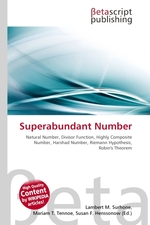Superabundant Number
Lambert M. Surhone, Mariam T. Tennoe, Susan F. Henssonow
бумажная книга
High Quality Content by WIKIPEDIA articles! High Quality Content by WIKIPEDIA articles! In mathematics, a superabundant number (sometimes abbreviated as SA) is a certain kind of natural number. Formally, a natural number n is called superabundant precisely when, for any m < n, frac{sigma(m)}{m} < frac{sigma(n)}{n} where ? denotes the sum-of-divisors function (i.e., the sum of all positive divisors of n, including n itself). The first few superabundant numbers are 1, 2, 4, 6, 12, 24, 36, 48, 60, 120, ... (sequence A004394 in OEIS). Superabundant numbers were defined by Leonidas Alaoglu and Paul Erd?s (1944). Unknown to Alaoglu and Erdos, about 30 pages of Ramanujan's 1915 paper "Highly Composite Numbers" were suppressed. Those pages were finally published in The Ramanujan Journal 1 (1997), 119-153. In section 59 of that paper, Ramanujan defines generalized highly composite numbers, which include the superabundant numbers.
Данное издание не является оригинальным. Книга печатается по технологии принт-он-деманд после получения заказа.


